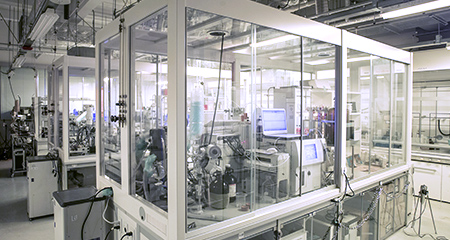Organic solar batteries
Using a clean and inexhaustible source of energy (solar), which has the promise of preventing global warming, organic solar cells are expected to be a major domestic energy source in the future.
The current power generation costs of the commonly used silicon solar cells still remains three times as high as domestic electrical power and six times as high as commercial electrical power. Therefore, for further expansion of solar cell usage, cost reduction is essential. Various new types of solar cells are currently under research, and development is designed to increase the usage of solar cells. Among these new solar cell types, organic solar cells show promise because they use inexpensive materials and require simple manufacturing processes. They are the next-generation solar cells that are expected to significantly reduce costs when compared with the silicon solar cells.

There are two major candidates for organic solar cells: dye-sensitized solar cells and thin-film solar cells. NARD Institute Ltd. is researching both these solar cells. Dye-sensitized solar cells allow a variety of shapes and colors by changing the electrode substrate materials and color of materials. For example, changing from glass to plastic film increases the substrate flexibility. In addition, because the dye-sensitized solar cells generate energy at weak room-light levels, they are expected to be used as interior accessories and indoor-use solar batteries. Dye-sensitized solar cells are drawing attention due to their wide range of potential applications. However, further improvements in efficiency and durability will be necessary for their practical use.
To achieve this, development of new materials is essential; colored materials play an important role. Although ruthenium complexes are currently being widely used, high purity levels are required; furthermore, the synthesis and refinement of ruthenium complexes are not simple.
In case of thin-film solar cells, organic semiconductors, such as fullerene and phthalocyanine, are used, and improved purity is anticipated.
With our extensive knowledge and experience in organic synthesis, our company can synthesize and refine colored materials. Furthermore, we can make a proposal from newly designed solar cell materials through the stages-of-synthesis pathway.
Related contents
Inquiries about products and technologies
Please contact us for consultations and inquiries regarding products and technologies.





